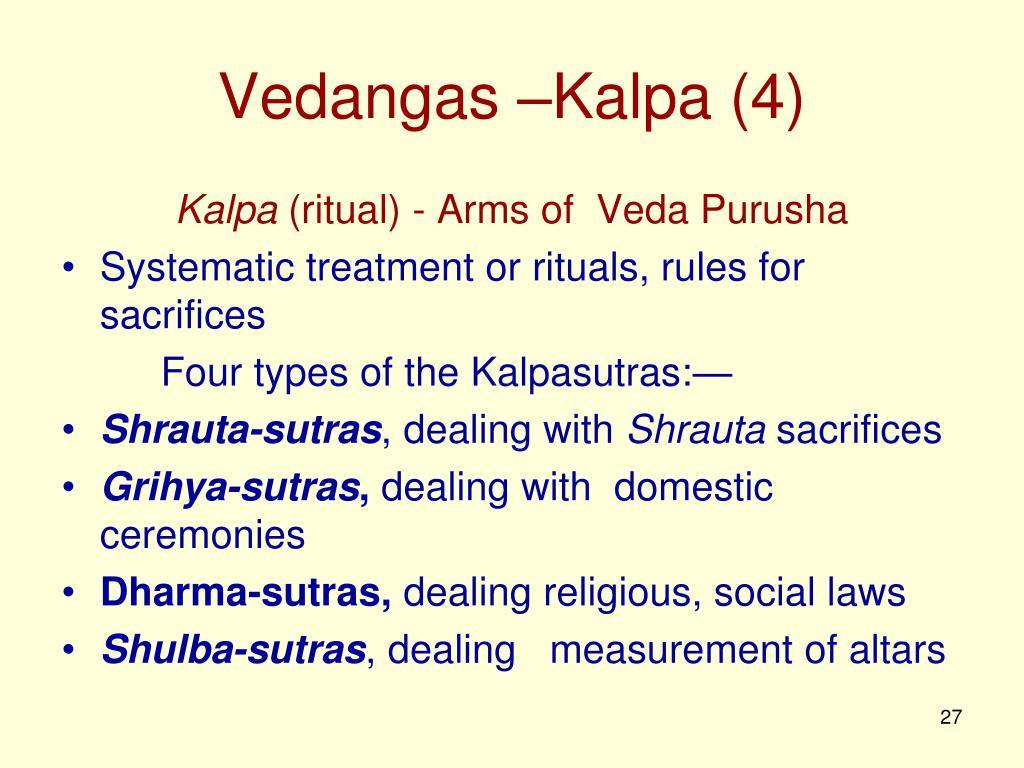Skip to main content
Vedangas III - Brief on Kalpa and Jyotisha
Introduction to Kalpa and Jyotisha
I. Kalpa - The Practical Guide

A. Definition
- Kalpa serves as a guide or user manual.
- Provides instructions and specific directions for all aspects of life.
* Includes personal, family, and social dimensions.
- Kalpa Sutras are practical guides that are useful in daily life.
B. Scope of Kalpa Sutras
- Kalpa Sutras are helpful in understanding all important aspects of ancient Indian life.
- Covers household life, ceremonies, and social norms and law.
- By reading the kalpa sutras one understands how the ancestors approached life and organised their activities.
C. Four Categories of Kalpa Sutras
-
Shrauta Sutras:
- Instructions and a guide for Vedic rituals.
-
Sulba Sutras:
- Deals with measurements and constructions, especially fire alters
- Sulba means ‘thread’, related to rope geometry, which is about creating geometric figures using ropes and poles.
- A circle can be generated by tying thread to a pole.
- Altars with 77 different designs (complex designs) were created using only threads and poles.
-
Grihya Sutras:
- Instructions for household ceremonies.
- Details on conducting rituals for daily life.
-
Dharma Sutras:
- Guide for social duties.
- Details on ‘dos and don’ts’ in a society and conforming to norms.
D. Example: Fire Altars
-
Construction: Vedic altars had complex designs created using a thread and a pole.
-
Types of Agni (Fire) altars:
-
Grahapatyagni: Circular altar, placed in the west.
-
Ahavaniyagni: Square altar.
-
Dakshinagni: Semi-circular altar.
-
Area Relationship: Crucially, the area of the circular altar had to be exactly equal to that of the square altar.
- Implies knowledge of pi(π).
- “pi r squared” (area of the circle) = “a squared” (area of square).
II. Jyotisha - The Science of Time and Astronomy

A. Definition
- Jyotisha is the knowledge of movement of stars and planetary bodies and their effect on time.
- Compared to the jewel on the head of a snake and the crest of a peacock, hence its precious nature
- Classified into Vaidika (Vedic related) and Laukika (worldly related)
B. Vedanga Jyotisha
- Vedanga Jyotisha focuses on Vedic related matters.
- Purpose is to fix time for performing Vedic rituals and activities.
-
Not focused on predicting future events (astrology).
- It is focused on the astronomical aspects rather than astrological predictions.
- Intention is to understand movement of the stars, sun, and the moon.
C. Purpose of Vedanga Jyotisha
- To determine the appropriate timing for various activities.
- This is achieved through careful observation and precise measurement of the movements of celestial objects.
- Not related to day to day predictions, which is not the intent of Vedanga Jyotisha.
D. Structure of Jyotisha
- Broadly divided into three parts:
-
Siddhanta: Mathematical calculations and formulation (Ganita) and astronomical observations (Gola).
- It includes planetary theory, arithmetical calculations and locations of earth and stars.
-
Samhita: Scientific and mathematical concepts of astronomy (Nimitta and Muhurta).
- Deals with some of the scientific and mathematical concepts
-
Hora: Astrological predictions, specifically, jataka (birth chart) and prashna (queries).
- It is a collection of some astrological predictions.
- Vedanga Jyotisha mainly uses Siddhantha and a part of Samhita to calculate time.
E. Classification of Vedanga Jyotisha
-
Rigvedic Vedanga Jyotisha: Consists of 36 verses
-
Yajurvedic Vedanga Jyotisha: Consists of 43 verses that outlines the basic ideas of astronomy.
III. Conclusion
-
Importance: Unless we have a proper understanding of Vedangas, what is prescribed in the Vedas cannot be properly understood.
-
Completeness: With the six Vedangas in place a holistic understanding of the Vedas is possible.


